In the northern-most state of India, one after another, many groups of people are continuously walking on a hill. In this crowd, there are women with their newborn babies, men with a bag on the shoulder, children enjoying their first outing with parents, there are 4 years old small children as well as 70 years old adults, some are walking barefoot and some have the costly shoes in the feet. There are group of four people carrying a PALKI (A chair like structure with two rods on the both end, so that four people can carry it on shoulders) of an old person as well as the group of men and women walking upward on the hill with a stick, some people are trekking, some are moving ahead on the back of a mule, some are even riding in a helicopter, some groups are going up and some are coming down. Suddenly a person shouts somewhere JAI MATA DI..Nobody knows who shouted and from where,but whole crowd present there, shout together in a single voice JAI MATA DI..Again, a person shouts Bol Saache Darbaar Ki and the crowd reply..JAI. These are the scenes on the way to the holy shrine of MATA VAISHNO DEVI, the second most visited Hindu Temple in India.
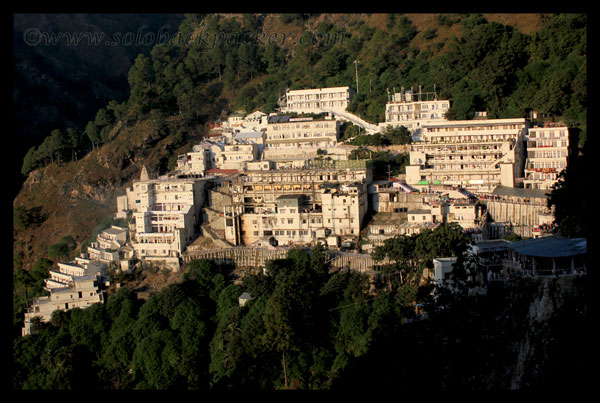
This shrine is basically a cave at the height of 1700 meters, where we believe that Mata Vaishno Devi resides. The area around the holy cave is known as the Bhawan and it can be reached after a relatively easy trek of 12 kms. The trekking routes are in very good condition, trek is easy and facilities are available for hiring a potter, a mule, a palki and even helicopters on the payment basis. But being a easy trek does not reduce the importance of this place. This is a common saying that only those people are able to reach till the caves, whom the Mata Vaishno Devi calls herself. You put numerous efforts, do lot of homework, but if she does not call you, you can never reach there. It may sounds orthodox in this modern age, but this is the common faith of the devotees all over the country. In the history of human evolution and modern civilization faith always overpowers the theory of sciences. You can not ignore this, even if you wish.
I am fortunate enough to receive the blessings of the goddess from last 10 years continuously. It all started in the summer of 2002, when I reached there suddenly in the search of snow. Since then, I visited this place 14 times and almost every year, only broken link was year 2011. Even today whenever I go to apply for the leaves to travel to Katra, I always think that I can use these leaves to explore another place, but faith overcomes this wandering heart and I always reach to Katra only. Till the time I am posted in Delhi, I am able to visit this place regularly, who knows the life after that? My present post gives a detailed information to the devotees who want to reach there. To make it simple and enjoyable, I divided the whole journey in three parts :
In the first part, you will travel from Jammu to Katra. Jammu is the most important station of the northern-most part of India and Katra is a small town in the base of Trikuta Hills, from where the journey to the shrine started. Distance between Jammu and Katra is 47 kms.
In the second part, you will trek from Katra to Adi Kumari Temple covering a trek of 8 kms (easy trek).
In the third part, you will trek from Adi Kumari Temple to Bhawan (6 kms, very easy trek) and then further to Bhairon temple (1.5 kms, moderate trek) and finally you will descend to Katra from Bhairon Temple.
So, start chanting the name of Maa Vaishno Devi from the heart and join me in this journey.
Reaching Jammu: Jammu, the winter capital of Jammu and Kashmir state is situated on the banks of Tawi river and considered as a focal point for all the tourists going further to the places like Vaishno Devi, Sri Nagar, Laddakh etc in the Jammu and Kashmir state. It is also projected as the city of temples owning to the large number of temples present in the city. National Highway 1A passes through Jammu to connect it to the Kashmir valley and further National Highway 1D goes to Leh via Kargil. When Leh-Manali Highway closes in the winter due to the heavy snow, Jammu-Srinagar Highway becomes the lifeline for the people of Kashmir and Laddakh valley. This road remains open throughout the year and also plays a crucial role for the constant supply of men and materials to the Indian Army posts at India-Pakistan Border. Being the second last railway terminal on that rail route and the largest rail-head of the state, Jammu remains packed with the travelers throughout the year.
Train Services to Jammu: Before the construction of Udhampur Railway Station, Jammu was the last station on this railway route. Now trains go up to Udhampur and soon they will reach up to Katra as the construction of that rail route is in its final phase (In May 2013, the construction of this route is finished) . In July 2013, two new trains are announced for Katra Railway Station (Station Code: KTAR) in the new time table of Northern Railway. First train, six-days a week (except Thursday ex- New Delhi) AC express train is from New Delhi, while second, bi-weekly train is from Kalka. These trains timings are already decided, but the date of commencement is not yet decided. So, we have to wait for some more time for these trains. At present, there is only two options to reach Katra, either a bus from Udhampur or a bus from Jammu Tawi. Jammu is well-connected to the every part of India with a good number of trains including Express, Rajdhani as well as Duronto express. These trains connect it to the other cities of India like Delhi, Kolkata, Mumbai, Varanasi, Ahmedabad, Bhopal, Chennai, Vijaywada, Kanyakumari etc.

Only few trains on this route go upto Udhampur. You can board a train up to Udhampur, But I recommend to catch a train till Jammu Tawi only. Udhampur railway station is about 5 kms away from the bus stand to catch a bus to Katra for another 33 kms journey. In Jammu, you can catch a bus just outside the station and reach within 2-3 hours to Katra, which is 47 kms away. From Udhampur, bus frequency to Katra is lower than Jammu. Jammu to Katra bus and taxi services operate 24 hours round the clock with less frequency in the night, so you should not worry about the arrival and departure timings of the trains at Jammu Tawi railway station. I feel Jammu is a convenient option in comparison to Udhampur for the onward journey.
Bus Services to Jammu: Jammu is a major city on the National Hinghway 1A between rest of India and Kashmir Valley. So plenty of buses are available from the northern states of India to Jammu. Volvo bus services are also available between Delhi-Jammu, Chandigarh-Jammu and Amritsar-Jammu. From Delhi, Volvo buses are even available upto Katra and take 12 hours for the entire journey. Fare is approx. 1100 INR. Ordinary government buses are also available from various parts of Rajasthan, Delhi, Punjab, Haryana, Uttarakhand, Uttar Pradesh and Himachal Pradesh to Jammu as well as to Katra.
Please note, there are two bus stands in Jammu to catch a bus to Katra. Either you can catch a bus from the railway station to Katra (fare 35 to 60 INR) or you can catch a bus from the general bus stand of Jammu, which is 5 kms away from railway station. Buses to Srinagar are mainly available from the general bus stand. There are small mini-vans known as matadors run between railway station and general bus stand.
Flight Services: Jammu Airport is located at the distance of 7 kms from Jammu Railway Station as well as from Jammu general Bus Stand. Regular daily flights of various regular as well as low-cost carriers are available from Delhi, Jaipur, Mumbai, Chandigarh, Srinagar and Leh.
Arrival at Jammu: Most of the trains from Delhi arrived in the morning hours at Jammu Tawi station (Station Code: JAT). Trains from Delhi generally remain on time expect during the foggy weather in winter. If you are traveling between September to March, expect a chilly night in the trains. Always take a blanket, unless traveling in AC coaches. Trains like Duronto Express provides blankets and pillows in the Sleeper Coaches also on the payment of INR 25 per set.

Once arrived in Jammu, you can explore a food-joint outside the station near bus stand for the breakfast. There is a good option Annapurna Bhojanalaya to enjoy the Paranthas and Curd in the morning.
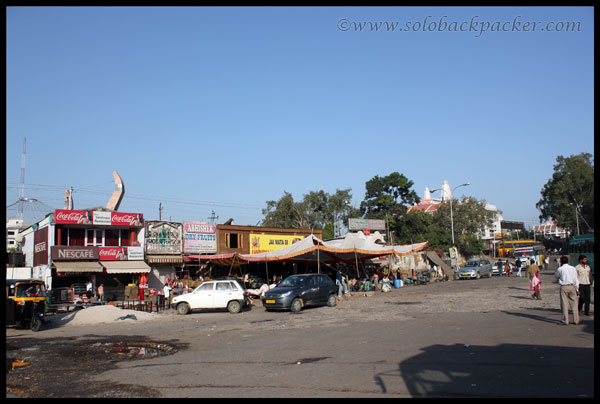
Jammu to Katra: After the breakfast, catch a bus to Katra from the bus stand in front of the dhaba. Bus fares vary from INR 35 to INR 60 per person, depending on the seating configurations in the bus. Board any cheaper bus as it is only 2-3 hours journey. Hired taxis and jeeps are also available from the railway station to Katra.
Journey between Jammu and Katra : The 2-3 hours journey from Jammu to Katra will take you on a highway that provides a majestic view of Tawi River and passes through a hilly terrains of beautiful rocks and amazing greenery in the surroundings. In the raining season, you can expect some scenic waterfalls along the way.
The bus generally stop on a road-side dhaba for the snacks and tea before reaching to a security check post of J & K police. This is a routine security check post on this route. All Male Passengers in the bus , with or without the bags , have to de-board the bus and they have to show their bags to the security personnel at the check post. But all Females can remain inside the bus and security people also do not touch any bags in the deck of the bus as well as on the roof of the bus. What is the logic behind this security check, I never understood.

The first view of Trikuta Hills from the check-post is amazing and you can click some distant pictures of the hill.
After a short ride from the security check post, you reach at Katra bus stand within 30 minutes.
Arrival in Katra: Katra is a small town in Reasi district and serves as the base camp for the trek to Maa Vaishno Devi shrine. There are plenty of hotels, guest-houses and dormitories available here for the stay and this list is only growing in the numbers every year.


Over the period of 10 years, a lot has been changed in Katra, but the basic things remain the same. Same is the Kulfi sellers (though we missed the kulfis this time), same are the hotel agents, same are the touts and same are the beggars. As usual, a mob of hotel and guest-house agents welcome you to offer the cheap hotels and restaurants and providing their free assistance on how to start the trek to the holy shrine. Don’t pay any attention to them and walk outside the bus stand area.
What to do in Katra? you have two options after your arrival in Katra:
If you are young, energetic and have lesser time, you can directly start the trek to holy shrine. No need to worry about bath, food and sleep. There is a waterfall Banganga on the way after 4 kms of trek to bath , plenty of the shops to eat and you can also get blankets to sleep at AdiKumari Temple after 8 kms of trek from Katra bus stand.
But if you are traveling with the family, having extra luggage or tired of the journey, you can opt to stay in Katra for a night or whatever duration you like. Plenty of hotels, guesthouses and dharamashalas are there, where you can stay for 1 hour to bath and to be ready or for a night to rest.

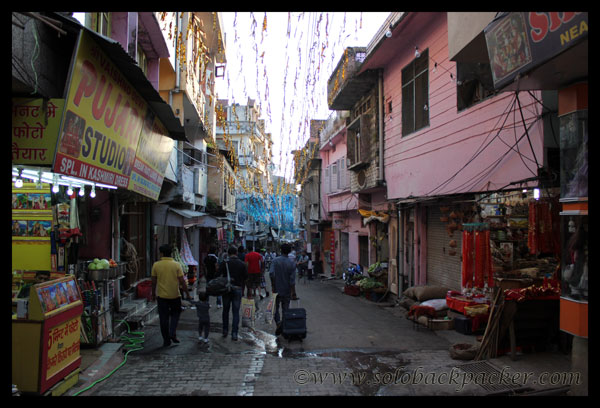
Whatever is the chosen option, but please always remember that before the start of the trek, you have to register at a registration counter in a building adjacent to the bus stand. This counter is popularly known as Yatra Parchi Counter and you have to get a yatra parchi before the trek. This slip will be checked at Banganga check post, and if you are without the slip, you will be asked to return from there to get a yatra slip. There are large notice boards available regarding the yatra slip at bus stand. Anyone can get a slip for whole of his group. Separate slips for each and everyone is not required. You have to cross Banganga checkpost within six hours of issue of this slip. So, if there is any plan to stay in Katra for more than 6 hours, it is always better to get this slip before the trek, later in the day. This slip will also insure you with INR 1 lac if any bad thing happens on the trek. The trek to holy shrine can commence at anytime in 24 hours of a day, but the opening time of Yatra Slip counter is from 06:00 AM to 10:00 PM only.


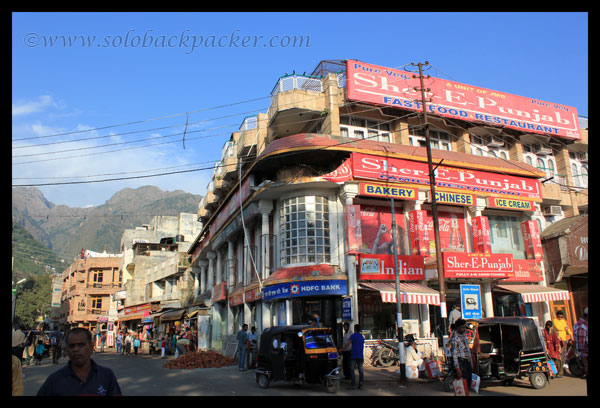
So, enjoy your stay in Katra and remain here for the next post which will take you to the journey till Adi Kumari Temple, the halfway of the trek route.



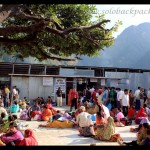


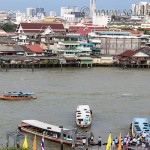

thanxs for gr8 description.mata bless u
Hi..Thanks for the detailed info. I m travelling in the first week of May with my 7 years old son n my mother. What should be the good time to climb u think? Night or early morning or arnd 3 pm in the evening?
Hi, I prefer to trek in the night at Mata Vaishno Devi. But, I think with family, you should start in the evening around 3-4 PM. During day, it will be really hot in May.
really discriptive yatra details very helpful …. GOD BLESS U
Jai Mata Di !!!
Jai Mata Di…Stay Blessed 🙂
Where do you walking stick for the trek? What are trhe normal offerings to the deity?
There are many shops along the trek route to get those sticks..Normal offerings are chunri,coconut, lachidana…a typical Indian prasad like any other goddess temple..These are available at the shops near bhawan. You can buy a packet. You can also offer hard currencies by dropping them in the designated boxes.
This is Excellent Description ….. Jai mata Di
Hi,
Liked your blog… Congrats on taking us through this journey…
We are planning to visit the shrine on 23rd Dec 2013…
In your reply to Anu you say “You may also get a chance to visit the original holy cave.”
Can you please enlighten me about the original holy cave.
Best Regards
Hi, there are two types of cave at Mata Vaishno Devi Shrine. The natural one is about 2 feet wide and filled with 2 feet deep water generally. Only one person can pass through this cave at a time and that too after lot of bending and leaning. In the winter season, when the crowd at this shrine becomes lesser, devotees are allowed to pass through this cave for the final darshan of Mata Vaishno Devi. In other season, you are supposed to move through the artificial tunnels (3 tunnels are there, 4-5 feet wide) to reduce the congestion inside the shrine. But in both cases, the main shrine of Mata Vaishno Devi ( 3 stones pindis) remains same to offer the prayers..
HI!… solo
thanks for the gud trek details ,,,, but can u plz explore about this one….
If one wants to go from jammu airport to bus stand which is (ie. 8 kms) from airport …what’s the approx fare( ie. for 4 members) for that or if there are buses available at the airport directly to KATRA.
TAXIS are not the option for me.
WAITING for ur kind response.
thanking u
Hi Vaibhav, No idea of the fare..I never went by Air..I don’t think those buses operate between Airport and Katra..I think, you have to come to the bus stand or railway station.
thanks for sharing your experience. It will really help me my family to put our prayers at holy shrine.
Jai mata di !!!
I am travelling in december this year, Can you please some details of crowd of devotees, wheather condition and other things which I should be taking care before starting my journey
Hi,
In December, you can expect less crowd on this yatra. You may also get a chance to visit the original holy cave. It will be a bit cold in December, so carry woolen clothes and a jacket with you.
Dear BRO Solo,
Thanks to you for providing the above information.Can you please provide us the information from katra to shivpodi yarta.i am desparetley waiting for your reply.
Warm regards,
BALKISHAN
Hi Balkishan,
Unfortunately, I never been to Shivkhori till now..So, I don’t have any detailed idea on this. There are cabs and shared jeep available from Jammu as well as Katra to Shivkhori. It is 140 kms north of Jammu and 80 kms from Katra in the district of Reasi.
Regards,
Avanish
I AM GOING LAST YEAR SHIVKHODI DHAM FROM KATRA VERY GOOD EXPERIENCE
When it is busy day, it takes 3-5 hours to obtain parchi. Someone told that one can take parchi online too – is that correct. Also you should provide information about Helicopter service – timings and fare from Katra to Sanjichat.
Hi Jai, you can book yatra parchi online..for that, visit the official website of Shri Mata Vaishno Devi Shrine Board. Below Home tab, there is an option for online services. Click on that and register yourself at the portal..Once you will get your username and password, you will be able to avail various online services such as yatra parchi booking, room booking, helicopter booking etc after log-in to the portal. You can book yatra parchi online for upto 30 days in advance. Same for the other services. Helicopter Services are operated by Global Vectra and Pawan Hans both. For Katra-Sanjhichhat, one way fare is currently INR 800 (which vary upto INR 1200 in peak season). For Katra-Sanjhichhat-Katra (two way) fare is Rs. 1600 currently. Helicopters depart almost at every 15-30 minutes between 8.00 AM to 5.00 PM, subjected to the weather conditions. Time-table and online booking facility is available at the Shrine Board Portal.